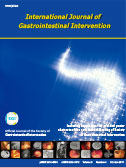
pISSN 2636-0004
eISSN 2636-0012
ABOUT THE IJGII
ARTICLE CATEGORY
ALL ARTICLES
For Contributors
-
POLICY



 pISSN 2636-0004
eISSN 2636-0012
pISSN 2636-0004
eISSN 2636-0012
 All Articles
All Articles
 Articles
Articles

Abstract : Non-surgical procedure-related, upper gastrointestinal bleeding (UGIB) is considered as one of the rarest of all UGIB causes, although it is a serious complication when it occurs. It presented as hematemesis, melena or hemobilia in which is associated with hepatobiliary intervention. In most patients the bleeding resolves spontaneously and in those in which it does not, the majority respond to conservative management. Endoscopy is the first line of treatment if bleeding does not stop after medical management, although if it failed due to massive bleeding, in hemodynamically unstable patients or in hepatobiliary procedure-related bleeding, endovascular or surgical intervention should be considered. In this manuscript we will discuss the endovascular diagnosis and treatment of non-surgical procedure-related UGIB.
Cited By: 2

Abstract :
Cited By: 1

 , Srikanth Moorthy, Sreekumar Karumathil Pullara, Nirmal Kumar Prabhu, Ramiah Rajesh Kannan, Puthukudiyil Kader Nazar
, Srikanth Moorthy, Sreekumar Karumathil Pullara, Nirmal Kumar Prabhu, Ramiah Rajesh Kannan, Puthukudiyil Kader NazarAbstract :
Cited By: 4

 , Kenji Yamao, Takuji Gotoda, Daiichiro Kikuta, Akinori Takei, Kunio Iwatsuka, Toshimi Takahashi, Masahiro Ogawa, Akihiro Henmi, Makio Kobayashi, Mitsuhiko Moriyama
, Kenji Yamao, Takuji Gotoda, Daiichiro Kikuta, Akinori Takei, Kunio Iwatsuka, Toshimi Takahashi, Masahiro Ogawa, Akihiro Henmi, Makio Kobayashi, Mitsuhiko MoriyamaAbstract :
Cited By: 0

 , Taro Shibuki, Gen Kimura, Kumiko Umemoto, Kazuo Watanabe, Mitsuhito Sasaki, Hideaki Takahashi, Hiroshi Imaoka, Izumi Ohno, Shuichi Mitsunaga, Masafumi Ikeda
, Taro Shibuki, Gen Kimura, Kumiko Umemoto, Kazuo Watanabe, Mitsuhito Sasaki, Hideaki Takahashi, Hiroshi Imaoka, Izumi Ohno, Shuichi Mitsunaga, Masafumi IkedaAbstract :
Cited By: 0

Abstract :
Cited By: 1

Abstract : This case report shows an effective esophageal stent placement via retrograde (transgastric) approach under fluoroscopic guidance in the interventional radiology suite. This alternative can be evaluated and offered to patients that suffer from a firm esophageal occlusion before a major procedure such as surgery can be considered. Thus, decreasing major surgery complications and improving the quality of life.
Cited By: 0

Abstract :
Cited By: 0

Hyung Ku Chon  and Seong-Hun Kim
and Seong-Hun Kim 
Int J Gastrointest Interv 2023; 12(1): 7-15
https://doi.org/10.18528/ijgii220037
Se Hwan Kwon  , Seung Yeon Noh
, Seung Yeon Noh  , and Joo Hyeong Oh
, and Joo Hyeong Oh 
Int J Gastrointest Interv 2023; 12(1): 37-42
https://doi.org/10.18528/ijgii220005
Int J Gastrointest Interv 2023; 12(2): 57-63
https://doi.org/10.18528/ijgii220004
Partha Mandal  , Barrett P. O'Donnell
, Barrett P. O'Donnell  , Eric Reuben Smith
, Eric Reuben Smith  , Osamah Al-Bayati
, Osamah Al-Bayati  , Adam Khalil
, Adam Khalil  , Serena Jen
, Serena Jen  , Mario Vela
, Mario Vela  , and Jorge Lopera
, and Jorge Lopera 
Int J Gastrointest Interv 2022; 11(1): 18-23
https://doi.org/10.18528/ijgii210028
Int J Gastrointest Interv 2021; 10(3): 96-100
https://doi.org/10.18528/ijgii210032
Dominic Andre Staudenmann  , Ellie Patricia Skacel
, Ellie Patricia Skacel  , Tatiana Tsoutsman
, Tatiana Tsoutsman  , Arthur John Kaffes
, Arthur John Kaffes  , and Payal Saxena
, and Payal Saxena 
Int J Gastrointest Interv 2021; 10(3): 128-132
https://doi.org/10.18528/ijgii200050


 pISSN 2636-0004
eISSN 2636-0012
pISSN 2636-0004
eISSN 2636-0012
| TODAY | 198 |
|---|---|
| TOTAL | 224,568 |
© The Society of Gastrointestinal Intervention. Powered by INFOrang Co., Ltd.